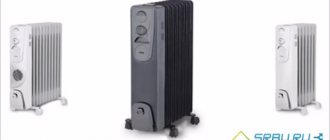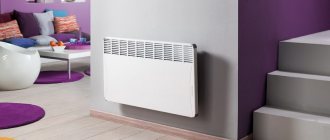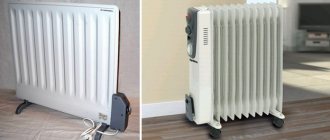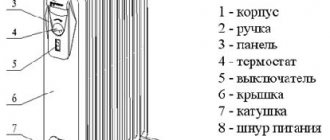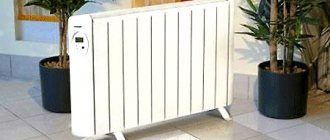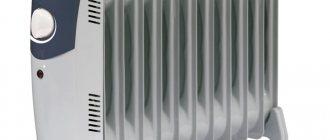Oil radiators are widely used as an additional source of heat in the house. When the main heating, often water heating, fails, an oil heater is used to protect the house from severe frosts. However, they can also be used as the main source of heat. It remains to figure out why electric wall-mounted oil heating radiators are better than other electric heaters and when they are more profitable than water heating.
Oil heaters (heating radiators)
Externally, an oil-type radiator is similar to a conventional sectional battery that hangs under the windows in apartments and houses. The only difference is the operating principle and the energy carrier - the portable radiator operates from the electrical network, and not from the central heat supply from the boiler room.
Design and principle of operation - how does it work?
The difference between an oil radiator and analogue stationary heating devices is that it operates from the mains. If in conventional batteries there is water inside the sections, then here there is mineral oil. When plugged into the network, such oil boils, heating the walls of the device, which, in turn, heat the room with warm air.
The operation of the equipment is ensured by:
- Thermostat.
- heating element.
- Control panel with plastic knobs and incandescent thermometer.
- A network cable that provides power supply.
The body of the product is made of metal, which is coated on the outside with a special anti-corrosion and anti-shock powder coating. It is this composition that helps to avoid surface damage to the plates with further deformation.
Each section of an oil-type radiator has a hermetic, dense base that does not allow the seams to separate when the oil heats up.
Advantages and disadvantages
Depending on the manufacturer, such a device has certain design features: an autonomous controlled thermostat or a touch control panel. But, in any case, the heating element has a number of advantageous characteristics, including:
- silent operation, no extraneous sounds occur when the oil is heated;
- high level of heat transfer - efficiency;
- long service life without the need for repairs - a guarantee of 5 years or more;
- does not emit chemical or other unpleasant odors when heated;
- Easily transported from room to room thanks to the available wheels;
- does not contribute to dry air.
Among the disadvantages, it is important to note such features as the long period from heating the heating element to the supply of heat to the space, as well as the large weight of the product. However, such disadvantages are relative - weight is not a problem, since there are wheels, and after heating, the temperature lasts longer than when using other heating devices.
Devices with a built-in fan heat the room faster; literally within 1-2 minutes after switching on, the radiator heats the room.
Is it dangerous? Safety precautions
Existing warnings regarding the toxicity of the oil in the radiator are unfounded.
Modern devices have double or triple protection, which, even with a direct impact, does not violate the integrity of the coating.
Hot oil is indeed under pressure inside and is a flammable component. But the degree of protection of the heater is so high that with proper operation for many years no negative aspects will be noted.
Each oil-type radiator has a glow sensor that is activated when heated to 60 degrees. Above this temperature, heating does not occur - the heating element turns off.
Design
The heat source in the oil radiator is an electric heating element. It almost completely converts the electrical power supplied to it into heat, and the spiral inside it can heat up to 800 degrees Celsius. In terms of performance, electrical appliances undoubtedly have the highest efficiency. However, direct heating of air from heating elements is accompanied by a number of disadvantages, which are clearly expressed in the operation of electric convectors:
- Upon contact with an element heated to 350°C or higher, the dust in the air instantly burns out, releasing substances harmful to human health and well-being, and oxygen is burned.
- Excess heat near the heating element increases convection currents, which leads to excessive air flow.
- To get rid of the first drawback, you have to constantly ventilate the room, thereby reducing the efficiency of heating, which entails increased electricity consumption, and the air quickly becomes dry.
Increasing the heat transfer area helps solve this problem. An outer casing is formed around the heating element, and the space between the electrical element and the casing is filled with mineral oil. The choice of oil is based on several aspects:
- Does not allow electric current to pass through in case of breakdown of the heating element housing;
- Has less thermal expansion than water;
- Has high thermal conductivity and heat capacity;
- Does not cause corrosion of the inner surface of the housing and protects the heating element from destruction.
An increase in the heat exchange area leads to the fact that even when the heating element is heated to high temperatures, the surface of the radiator does not rise above the permissible 80-85°C.
The fact that the oil warms up first, and only then the heat is transferred to the air, does not in any way affect the performance of the oil cooler, although this is often presented as a disadvantage. In any case, all the heat from the heating element will transfer to the outer surface and then to the air in the room. Only the inertia of the system changes. If convectors and fan heaters almost instantly begin to heat up after switching on, but cool down just as quickly after switching off, then the oil radiator warms up with greater inertness for up to 5-10 minutes and remains warm for about the same amount of time after switching off, gradually giving off heat to the air.
Advantages:
- Electrical safety;
- High inertness and heat capacity;
- Safe surface temperature;
- Does not dry out the air and does not burn oxygen;
- Affordable price and durability.
Flaws:
- Increased safety requirements that must be taken into account during operation.
- Impossibility of centralized heating control.
Oil radiators, like any other electric heating devices, should absolutely not be covered with cloth or any other objects. In any case, the heating element will continue to generate heat and, if it has nowhere to go, overheating will inevitably occur with burnout of the coil and a high risk of fire. For oil radiators, this also threatens the oil overheating, which can cause the sealed housing to burst.
Radiator shape
Wall-mounted oil radiators differ from floor-mounted ones only in the method of fastening and the slightly modified shape of the outer casing.
If the usual floor-standing models have a characteristic rib and a wide profile of the device, then wall-mounted devices are narrowed so as to take up less space and reduce the load on the fasteners. Wall-mounted radiators are often supplied by the manufacturer with a stand for floor installation, while floor-standing radiators can be hung on the wall if desired. However, wall-mounted models still take into account one important point. It is not at all necessary to heat the wall, so one of the sides of the radiator can easily do without active heat exchange so that maximum heat can be transferred to the air inside the room using direct heat exchange, increased convection and thermal radiation. This can be a blank metal plate as a heat shield or fins on the radiator body, providing increased air convection to remove heat from the near-wall plane of the device.
The controls are traditionally already located at the end of the radiator. This is also due to the ability to separate the radiator and thermostat, which corrects the operation of the heater, and protect the plastic parts of the control panel from overheating. In addition, the side positioning of the buttons and control panel does not increase the width of the radiator, and there are no protruding parts on the front.
Energy saving
Electric heaters are always equipped with a thermostat. It is needed to optimize the operation of the device. The user sets the required temperature on the thermostat and, as soon as the air in the room warms up sufficiently, the power to the heating element is automatically turned off.
In addition, oil-fired wall-mounted radiators are often equipped with a power regulator, which also affects heating comfort and energy saving. During the transition period in spring and autumn, as well as in the absence of severe frosts, there is no need to turn on the heating at full power, only a third or half is enough and the power regulator helps limit electricity consumption. The main idea for using a thermostat and power regulator is to provide smooth heating without surges and reduce energy consumption when there is no need to use full power.
The power regulator for cheap and simple models is made two-position to turn on all the heating elements or only half of them. Models that are more expensive and of higher quality allow you to set the required radiator power over a larger range and in smaller increments, allowing the user to more accurately control the process.
Wall-mounted electric radiator with thermostat
With sensors
“Smart” radiators are able to independently determine the rate of cooling of the air in the room, that is, heat loss, and set the optimal operating mode of the heater. Using air temperature sensors, heating elements and the surface of the heat exchanger, they allow the controller to determine the best operating mode.
However, the presence of complex electronic filling in itself reduces the reliability of the heater. A mechanical thermostat and a simple power regulator with two or three positions will reliably last much longer, and their durability is not reduced by exposure to high temperatures and changes, unlike microcircuits.
Classification and main characteristics
There are many oil-type radiators, which differ in the number or presence of additional options - built-in mechanisms, fans or place of operation.
Wall mounted
Models that can be attached to a vertical surface are called wall-mounted. They tend to be flatter and have non-protruding sections that do not interfere with the bracket's ability to catch on the hanging hooks. Often such modifications are universal - they have a place for screwing on wheels, which allows you to install them on the floor in the right place.
Floor-standing
This type is the most common and is popular due to its portability: if it is necessary to heat several rooms, it can be reinstalled with little physical effort.
The heat transfer of such a floor-mounted device is the highest. There is a separate subtype of floor models - baseboard heaters. They are installed in the corner of the wall and floor in place of the baseboard. They have a long and narrow shape.
Tabletop
Modifications that can be placed on a table are small in size and the same weight. They are designed to provide additional heating to a small room. Also used in the form of heating a children's room or crib.
The number of sections for tabletop types is no more than 5; the height of such sections is half that of floor ones.
For cots
Radiators designed for heating children's rooms differ, in most cases, in their appearance and mobility.
These can be either wall or tabletop modifications with bright colors. A significant advantage of using such a heating element is that the air does not dry out, and the humidity during battery operation is at least 60%, which is important for children who are often ill.
Children who often suffer from acute respiratory viral infections or chronic lung diseases - bronchitis, laryngitis, tracheitis - need constant air humidification. Fans that operate on the principle of a hair dryer cannot be used to heat a room - they heat up and move air around the room.
Results
By all indications, oil heaters should gradually disappear from the market. After all, they are being replaced by more efficient and economical types of devices. However, manufacturers are not giving up and are improving designs to increase efficiency and reduce energy costs. Various add-ons, such as a humidifier or access via a smartphone, also help in this matter.
Gentle warmth, noiselessness and an affordable price tag allow radiators to remain favorites among many buyers. It’s too early to write them off: with modern solutions they can compete with more advanced technology.
Tell me, do you use a heater? If yes, what type of heater did you choose for yourself and why?
Tips and tricks for choosing
Radiators are produced with different power, which, among other things, depends on the number of sections: the more there are, the larger the heating area. The disadvantage of increasing the number of sections is the need to provide more space, which is difficult in small rooms. Although, such parameters for assessing characteristics are individual and this does not affect the mobility of equipment. In general, when purchasing an oil-type heater, pay attention to several features.
Continuous operation of the oil battery – 3 days.
Electricity consumption and the most energy efficient range
The convenience of oil radiators is obvious, but some buyers are confused by the energy consumption of such an installation - how much does the battery use per day? The power of the device is selected according to the size of the heated room. On average, heating 10 sq/m of space requires 1 kW of energy, if it is a living space with ceilings of 2.75-3 m. If the ceilings are higher, the calculation is carried out:
- The area of the room is calculated - the length is multiplied by the width.
- The volume of the room is determined by multiplying the area by the height.
- Divide the resulting number by 25 (because 25 m3 produces 1 kW).
- The result obtained is the heater power we need. If the quantity is very large, then you need to buy several radiators, which in total will provide the required energy
So, according to the above calculations, it turns out that for a room of 20 square meters. m, a 1.5 kW heater is suitable.
Dimensions and appearance (flat, small)
The height of one section is from 580 to 700 mm, width is 362-650 mm. The depth of the section to the central part is 90-290 mm. The number of such sections is 5-12, the most popular models with 9 or 11. They are flat, wide or narrow in shape. The smallest ones are plinth ones, their length is up to 1.5 meters, diameter is 50-90 mm.
The surface temperature differs from the maximum heating of the oil itself. So, if the oil is heated to a temperature of 60 degrees, then the surface of the sections heats up to 95°C.
Control
The control unit for oil convectors is located on the side of its end part. As a rule, this is a plastic panel with switches that control:
- operating modes;
- light indicators;
- humidifiers;
- shutdown sensors when the device overheats;
- duration of operation of the TEN;
- air heating temperature;
- Energy consumption;
- fan operation;
- duration of rest mode during continuous work.
Some modern models have LCD monitors with touch controls even from a distance.
Manufacturer and price - how to choose?
The range of products for heating autonomous rooms is large. Almost any household store has several manufacturers, but according to customer ratings, the most frequently purchased are:
- Vitesse VS-877.
- General Climate.
- Timberk.
- DeLonghi.
- Bimtek.
The price of radiators, depending on the number of sections and the manufacturer (domestic or imported), starts from 3 thousand rubles to 30 (for domestic needs, other amounts for industry).
Types of devices
Depending on the external design and installation method, there are two main types of heaters.
- Ribbed
Otherwise they are also called sectional. The most popular and affordable devices. In appearance, they resemble old cast iron radiators or modern bimetallic ones.
This structure ensures maximum heat transfer. However, the design itself is quite bulky and heavy, therefore, as a rule, it requires floor installation. This option is not always suitable for small spaces.
- Flat
Another name is panel. They are quite rare on sale. They are two solid plates welded together. There are grooves in the housing for the heating element and liquid.
The performance of such samples is lower. But they require less electricity, which is why in some cases they are called energy-saving. They are also distinguished by their lighter weight, so the device can be mounted to the wall. Although installation on the floor, on supports, is also acceptable.
For industrial purposes or for home: household or industrial
If for domestic needs there are a large number of offers at different prices, then for industry there is a separate line of products that differ in power, size and, accordingly, price. The maximum number of sections of one oil radiator is 14. For industrial premises, it is important not only their required number, but also their correct location. Thus, suspended models heat the air faster, and the power of the device must be at least 2.5 kW.
Where can I buy
To avoid running into fakes, buy equipment only from reliable stores. Among the Internet platforms are:
- AllTools - the largest selection;
- MirCli – 154 options for all kinds of heaters;
- Polaris is the company’s official online store;
- Citylink - a decent assortment and constant discounts;
- Eldorado – 75 devices at different prices;
- Leroy Merlin – budget devices on sale;
- Refrigerator – 80 electrical appliances;
Installation
Installation of the heater does not require special skills and knowledge. If it is a hanging model, it is mounted on brackets that are pre-installed at the required distance from each other. If the model is mobile on wheels, then all that is needed for installation is to determine the safest place near the outlet. It is worth considering that there should be no obstacles in the heater’s path - curtains, sofas or chests of drawers. It is best to install it in the central part of the room in the first 2-3 hours of operation. After the space has warmed up, it is moved to a more comfortable distance - near a wall or fireplace.
What to look for when choosing?
When choosing such a device, you need to pay attention to a number of important factors:
- Power . It should be assumed that 1 kW of power can more or less effectively heat 10 m2 of area. To heat a large room, it is recommended to use several devices.
- Number of sections . There are household devices with the number of sections from 5 to 15 pieces. It is believed that the more of these elements there are in the heater, the more efficiently the device operates. The best option for an average home is a device with 6–8 sections.
- Auxiliary components . These are a temperature regulator, overheat protection, an operating mode switch (without them the device will not function normally) and a light indicator, a built-in fan, a timer, a humidifier (often not so necessary components). The presence of additional functions greatly affects the price of the device.
Oil
Transformer oil is a dielectric with excellent thermal conductivity.
It retains its properties at temperatures down to -45 degrees. Produced from oil by distillation, it has slightly different characteristics. For oil batteries, mineral oil is used, which is similar to transformer oil. Filling the radiator with synthetic gear oil will contribute to its noisy operation - it will begin to make noise and rattle due to the fact that the viscosity is lower and the intensity of convective flows is higher.
It is impossible to use a mixture of oils of different origins for radiators due to the interaction of the different additives present, which after heating it is not known how they will behave. The composition may either curdle or precipitate or thicken. Adding the missing oil is done with identical material available in the device.
Customer Reviews
Vsevolod Z.
RESANTA OM-12NV
Reliable mechanical control of heating modes. There are wheels for ease of movement. The radiator is protected against overheating. Built-in fan heater. Such an oil radiator quickly and evenly heats the room. The device does not emit any burning smell during operation. Oxygen is not burned, so it is comfortable to be in the room. It’s convenient that they came up with a thing with a fan heater; the heat is distributed faster and more evenly over the entire area.
Paul
Ballu Classic BOH/CL-07
The main thing to consider is that the heater is small in size! Approximately 60-70% of conventional heaters. Therefore, the real power of 1.5 kW is realized conditionally. Since the heat radiation area is smaller than that of “standard” heater heaters, at maximum mode it operates not according to a thermostat, but according to an overheating sensor. In a room with a temperature above 15 C° there is no point in turning on the 3rd mode. In the first mode, the distant sections from the thermostat hardly heat up. In general, the heater is normal and compact. The most optimal mode is 2nd, the thermostat works as intended and warms up completely and evenly.
ya.ella-21
Timberk TOR 21.1507 BC/BCL
It withstood the autumn season at the dacha properly, and will also provide warmth in the spring)) Nothing wobbles, does not creak, it is very compact, the oil radiator is actually good and convenient (not heavy, and there are no difficulties in transportation). There is no noise during operation and no unpleasant smell of oil, which is very important. I was pleased that it can heat a room of 16 square meters + convenient adjustment system. You can sharply add and reduce power, but also smoothly adjust it as needed. In general, everything is great! I would also like to note the high-quality assembly (all parts are fitted) and also high-quality paint)) I was pleased that after 3 months everything was fine with the paint. Very happy with the purchase.
Andrey N.
RESANTA OM-9NV
Great heater. It always saves us as soon as the heating is turned off. We live in an apartment. Therefore, these periods of transition from central heating cause discomfort. There is a child in the house. The “Resanta” heater is our lifesaver!!!! The price was a pleasant surprise. That's why we bought it. And the salesman in the store recommended it to us, saying that they are long-lasting. We hope that it will live up to our expectations. Not noisy. Easy. Mobile. Overall a great heater.
Nikolay Sushilin
General Climate NY17LF
Design. Reliability. Heating speed. There is a fan for quick heating. Silent work. No odors. Low energy consumption. This device has several ways to use and customize it. Read the instructions. Everything is easy there. And when turned on, it makes soft clicking noises for three to five minutes. This does not indicate a malfunction. This heats up the element. Then all sounds disappear. And it works silently.
Natalia Lyapunova
Ballu Classic BOH/CL-11
I turn it on at medium power and for a long time. room 25 sq.m. warms up in 1.5-2 hours, a room of 18 sq.m. in 1-1.5 hours. absolutely silent. Another 3 months passed and it simply stopped working. Neither the power light comes on nor the shift levers rotate. I didn’t work around the clock, didn’t fall, didn’t figure it out. But it stopped working. I don’t want to and won’t bother with returns and service centers, because taking the goods to the service center and then picking it up, possibly paying for diagnostics and repairs, is expensive and I don’t see the point. What’s the point of all this - I will no longer buy such goods in any marketplace. It’s better to buy it at the store and bring the faulty one back there.
Denis
Timberk TOR 21.1507 BC/BCL
Relatively small radiator. Heats up quickly, does not cool down immediately. Temperature adjustment is convenient and clear. One of the advantages is normal portability, you can warm up one room and carefully move it to another, there is a handle and wheels. In principle, it’s enough for a comfortable stay even on a balcony with open windows for half of that same balcony.
Valeria K.
Ballu Classic BOH/CL-07
I like the appearance of the radiator, it has 7 sections, it is white. This heater fits well into the interior of a room or apartment/office. The radiator is very neat in appearance, it is on wheels - it is convenient to move it. There is a special compartment for the cord where it is wrapped. From an interior point of view, such a radiator will suit almost any apartment, in my opinion. The Ballu BOH/CL-07WRN 1500 oil radiator operates silently. The power consumption of this radiator is 1500 W, it can heat a room up to 20 square meters. The Ballu BOH/CL-07WRN 1500 heater has 3 modes and even at its maximum it does not always cope perfectly with heating a large room. The Ballu BOH/CL-07WRN 1500 radiator has mechanical control. It says not to put anything on it because it could cause a fire.
Sergey Kozlov
Ballu Trend BOH/TR-09 2000
The combination of simplicity of design and low cost, together with favorable reviews from colleagues, was the reason for purchasing this particular model for the office. The choice paid off; now we work in the heat all year round. The warm-up time is normal for such radiators, it produces quite a lot of heat and, most importantly, it works fully automatically, without requiring attention. It is quite safe; if it overheats, it actually turns off immediately.
Petr Belousov
RESANTA OM-7NV
Among the shortcomings of the heater, I would only mention its dimensions. For such a large device with seven sections, you need to find a permanent place in the apartment. Otherwise good. Not overloaded control panel. There is a fan built into the case that increases the heating speed, dispersing heat throughout the room. The thermostat itself monitors the maintenance of the set temperature, turns off the device when it considers it necessary or switches it to maintenance mode. The stores are overflowing with a wide variety of heaters, my eyes run wild, but I remain true to myself and to oil heaters in matters of heating. In my entire life of use it has never let me down. It looks like most similar heaters, quite neutral, but heavy due to the metal body and oil. The temperature is adjustable. Special indicators function when turned on or when there are malfunctions. Equipped with a fan, this is a godsend; the heat is distributed throughout the room faster. Separately, an attachment for drying clothes was purchased and adapted for it, so it is used not only for heating the room.
Which is better: oil or convector
When considering the advantages of convectors or oil radiators, it is worth paying attention to such features as power consumption, dimensions and additional functions. If the heater is needed for regular use, then it is better to choose oil models. For periodic use in insufficiently warm rooms, you can buy convectors with a top supply of warm air.
Heating an apartment or house is a task that arises quite often even with centralized heating. This is due to insufficiently warm stationary radiators or poor location of the apartment, damp weather before the heating season or a desire to better warm up the child’s room. In any case, oil batteries will help ensure the desired temperature in residential areas.
Power
The main question when choosing an oil radiator is its power. How many kW will be enough if it is needed only to help the main heating system and how much will be needed to fully heat the house?
In the first case, you should consider a situation where the main heating for some reason has failed. For example, the electricity was turned off, and the circulation of the coolant depends on the pump, or for some reason there was not enough fuel for the solid fuel boiler, or there were interruptions in gas supplies. Such problems are usually solved within one or two days, with rare exceptions, and therefore it is necessary to keep the house warm in conditions of cooling radiators.
A wall-mounted oil radiator is installed permanently and to serve one room; the easiest way is to take half of the thermal power of the existing heat sources and add 10% on top for reserve. This is quite enough to maintain a comfortable temperature in the room.
If oil radiators are the only and main source of heat, then their power should be enough to replenish heat loss in each room. You should focus on the standard calculation, in which for every 10 m2 of area you need 1 kW of thermal power with a standard ceiling height of 2.5 meters. However, it is better to calculate in detail the heat loss of the building based on the existing insulation of walls and ceilings, and take a more accurate value.
The formula will help to estimate the heat loss of walls:
Q=(1/∑(d/λ))*ΔT*S,
where d is the thickness of one of the layers of the wall pie, λ is the thermal conductivity of the corresponding material, ∑(d/λ) is the sum of the thermal conductivity of the entire wall pie, ΔT is the difference between the temperatures inside the room and the average minimum during the heating season, S is the area of the wall for which calculation. For floors, it is enough to increase the obtained value by 20%.
The power of the oil radiator must exceed by 10% the obtained heat loss value for the room in which it will be installed. Naturally, for each room in the house it is better to determine the optimal value and select the appropriate heater. Most manufacturers produce in their lines models of the same design and control method of varying power.


